| 1 |
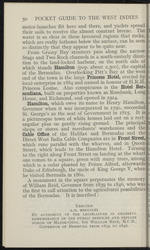 |
“...white houses laid out on a rect-
angular plan on gently rising ground. The principal
shops or stores and merchants’ warehouses and the
Cable Office of the Halifax and Bermudas and the
Direct West India Cable Companies are in Front Street,
which runs parallel with the wharves, and in Queen
Street, which leads to the Hamilton Hotel. Turning
to the right along Front Street on landing at the wharf
one comes to a square, green with many trees, among
which is a cedar planted by Prince Alfred, afterwards
Duke of Edinburgh, the uncle of King George V, when
he visited Bermuda in 1862.
A monument in the square perpetuates the memory
of William Reid, Governor from 1839 to 1846, who was
the first to call attention to the agricultural possibilities
of the Bermudas. It is inscribed:
ft
Erected
A.D. MDCCCLXI
By authority of the legislature in grateful
REMEMBRANCE OF THE PUBLIC SERVICES AND PRIVATE
worth of Major-Genl. Sir William Reid, K.C.B.,
Governor of Bermuda from 1839 to 1846....”
|
|
| 2 |
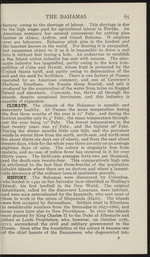 |
“...identified as Watling’s
1 Island), his first landfall in the New World. The original
[inhabitants, called by the discoverer Lucayans, were indolent,
3 and were soon exterminated by the Spaniards, who sent most of
(them to work in the mines of Hispaniola (Haiti). The islands
vwere first occupied by Bermudians. Settlers went to Eleuthera
i in considerable numbers from the Bermudas in 1647-1660, and
ssome years later also to New Providence. In 1670 the islands
«were granted by King Charles II to the Duke of Albemarle and
(jothers as Lords Proprietors, who, however, on October 27th,
11717, surrendered the civil and military government to the
uCrown. Soon after the foundation of the colony it became one
cof the chief haunts of the Buccaneers, who degenerated into
F...”
|
|
| 3 |
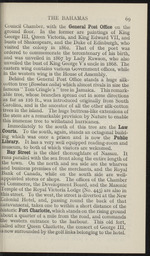 |
“...THE BAHAMAS 69
■ Council Chamber, with the General Post Office on the
■ ground hoor. In the former are paintings of King
I George III, Queen Victoria, and King Edward VII, and
I busts of Shakespeare, and the Duke of Edinburgh, who
I visited the colony in 1862. That of the poet was
I ordered to commemorate the tercentenary of his birth,
If and was unveiled in 1867 by Lady Rawson, who also
I unveiled the bust of King George V's unde in 1868. The
I eastern wing contains various Government offices, while
in the western wing is the House of Assembly.
Behind the General Post Office stands a huge silk-
tcotton tree (Bombax ceiba) which almost rivals in size the
[famous “ Tom Cringle’s ’’ tree in Jamaica. This remark-
! able tree, whose branches spread, out in some directions
’as far as 116 ft., was introduced originally from South
«Carolina, and is the ancestor of all the other silk-cotton
|itrees in the island. The huge buttress-like extensions of
the stem are a remarkable provision by Nature...”
|
|
| 4 |
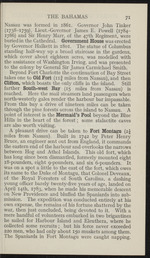 |
“...forest; some stalactite caves
are also worth visiting.
A pleasant drive can be taken to Fort Montagu (2J
miles from Nassau). Built in 1742 by Peter Henry
Bruce, an engineer sent out from England, it commands
the eastern end of the harbour and overlooks the narrows
between Hog and Athol Islands. This old fort, which
has long since been dismantled, formerly mounted eight
18-pounders, eight 9-pounders, and six 6-pounders. It
was on a spot a little to the east of the fort, which owes
its name to the Duke of Montagu, that Colonel Deveaux,
of the Royal Foresters of South Carolina, a dashing
young officer barely twenty-five years of age, landed on
April 14th, 1783, when he made his memorable descent
on New Providence and bluffed the Spaniards into sub-
mission. The expedition was conducted entirely at his
own expense, the remains of his fortune shattered by the
war, then just concluded, being devoted to it. With a
mere handful of volunteers embarked in two brigantines
he sailed for Harbour Island...”
|
|
| 5 |
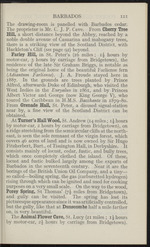 |
“...noble double avenue of Casuarina and mahogany trees,
I there is a striking view of the Scotland District, with
I Hackleton’s Cliff (see page 92) beyond.
Farley Hill, in St. Peter’s (16 miles; 1J hours by
I motor-car, 3 hours by carriage from Bridgetown), the
I residence of the late Sir Graham Briggs, is notable as
I being the original home of the beautiful Farliense fern
I (Adiantum Farliense). J. A. Froude stayed here in
I 1887. In the grounds are trees planted by Prince
I Alfred, afterwards Duke of Edinburgh, who visited the
I West Indies in the Euryalus in 1861, and by Princes
I Albert Victor and George (now King George V), who
I toured the Caribbean in H.M.S. Bacchante in 1879-80.
I From Grenade Hall, St. Peter, a disused signal-station
I near by, a fine view of the Scotland District can be
I obtained.
At Turner’s Hall Wood, St. Andrew (14 miles; 1J hours
I by motor-car, 2 hours by carriage from Bridgetown), on
I a ridge stretching from the semicircular cliffs at the north-
I east,...”
|
|
| 6 |
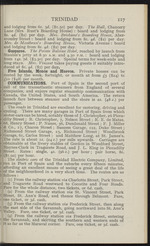 |
“...■panada, the United States, and South America. The return
■launch fare between steamer and the shore is 2s. (48 c.) per
■passenger.
I] The roads in Trinidad are excellent for motoring, driving and
[cycling. There are many garages in Port of Spain from which
■motor-cars can be hired, notably those of J. Christopher, 26 Picca-
•dilly Street; R. Christopher, 7, Nelson Street; R. E. de Matas.
■68, Henry Street; P. Nunes, 36, Dundonald Street; F. J. Miller
||& Co., 17, Chacon Street; Success Garage, 122, Duke Street;
■Richmond Street Garage, 25, Richmond Street; Woodbrook
■Garage, 61, Carlos Street; and Matthew Long, at St. James’s.
■The rate is about is. (24 c.) per mile upwards. Carriages are
■(ibtainable at the livery stables of Gordon in Woodford Street,
■Haynes-Clark in Tragarete Road, and J. L. King in Piccadilly
«(Street. Rates: single, 4s. (96 c.) per hour; pair horse, 8s.
■ ($1.92) per hour.
II The electric cars of the Trinidad Electric Company, Limited,
■run in Port of Spain and the suburbs...”
|
|
| 7 |
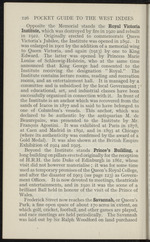 |
“... This anchor, which was
declared to be authentic by the antiquarian M. de
Beaurepaire, was presented to the Institute by Mr.
Francois Agostini. It was exhibited at Paris in 1878,
at Caen and Madrid in 1892, and in 1893 at Chicago
(where its authenticity was confirmed by the award of a
Gold Medal). It was also shown at the British Empire
Exhibition of 1924 and 1925.
Beyond the Institute stands Prince’s Building, a
long building on pillars erected originally for the reception
of H.R.H. the late Duke of Edinburgh in 1861, whose
visit did not however materialise; it was for some time
used as temporary premises of the Queen’s Royal College,
and after the disaster of 1903 (see page 123) as Govern-
ment Offices. It is now devoted to meetings, theatricals
and entertainments, and in 1920 it was the scene of a
brilliant Ball held in honour of the visit of the Prince of
Wales.
Frederick Street now reaches the Savannah, or Queen’s
Park, a fine open space of about 170 acres in extent, on
which golf...”
|
|
| 8 |
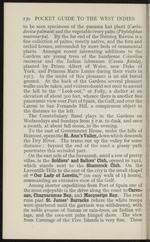 |
“...GUIDE TO THE WEST INDIES
to be seen specimens of the panama hat plant (Carlu- ]
dovica palmata) and the vegetable ivory palm (Phytelephas I
macrocarpa). By the far end of the Nutmeg Ravine is a I
fine collection of palms, mostly native, and the fern and I
orchid houses, surrounded by more beds of ornamental
plants. Amongst recent interesting additions to the
Gardens are young trees of the handsome Colemllea
racemosa and the Indian laburnum (Cassia fistula),
planted by Prince Albert of Wales, now Duke of I
York, and Princess Marie Louise during their, visits in I
1913. In the midst of this pleasance is an old burial I
ground. At the back of the Gardens several pleasant I
walks can be taken, and visitors should not omit to ascend I
the hill to the “ Look-out,” or Folly, a shelter at an I
elevation of about 300 feet, whence there is another fine I
panoramic view over Port of Spain, the Gulf, and over the I
Caroni to San Fernando Hill, a conspicuous object in I
the distance to the left.
The C...”
|
|
| 9 |
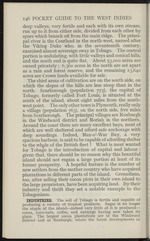 |
“...146 POCKET GUIDE TO THE WEST INDIES
deep valleys, very fertile and each with its own stream,
run up to it from either side, divided from each other by
spurs which branch off from the main ridge. The princi-
pal river is the Courland in the north-west, named after
the Viking Duke who, in the seventeenth century,
exercised almost sovereign sway in Tobago. The central
portion is undulating, with little valleys and conical hills,
and the south end is quite flat. About 53,000 acres are
owned privately; 6,360 acres in the north are set apart
as a rain and forest reserve, and the remaining 13,640
acres are Crown lands available for sale.
The chief areas of cultivation are on the south side, on
which the slopes of the hills are less steep than in the
north. Scarborough (population 773), the capital of
Tobago, formerly called Fort Louis, is situated at the
south of the island, about eight miles from the south-
west point. The only other town is Plymouth, really only
a village (population 763), on...”
|
|
| 10 |
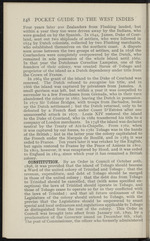 |
“...GUIDE TO THE WEST INDIES
Four years later 200 Zealanders from Flushing landed, but
within a year they too were driven away by the Indians, who
were goaded on by the Spanish. In 1642, James, Duke of Cour-,
land, sent out two shiploads of settlers, who were followed in
1654 by Dutch colonists, collected by two Flushing merchants,
who established themselves on the southern coast. _ A dispute
soon arose between the two groups of settlers, and in 1658 the
Courlanders were completely overpowered by the Dutch, who
remained in sole possession of the whole island until 1662.
In that year the Dutchman Cornelius Lampsius, one of the
founders of their colony, was created Baron df Tobago and
proprietor of the island as a Dutch dependency under title from
the Crown of France.
In 1664 the grant of the island to the Duke of Co'urland was
renewed. The Dutch refused to recognise his title, and in.
1666 the island was captured by privateers from Jamaica. A
small garrison was left, but within a year it was compelled...”
|
|
| 11 |
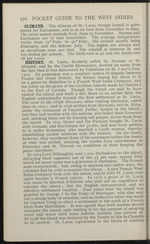 |
“...years was a grievance in Barbados. The French
were overpowered ; but, owing to sickness and native wars, the
colonists had by 1666 evacuated the island. A new French West
India Company took over the island, and in 1667 St. Lucia once
again became a French colony. In 1718 a grant of St. Lucia
was made to Marshal d'Estrées who sent out an expedition to
colonise the island ; but the English remonstrated and no
effective settlement resulted. Four years later the island was
eranted bv George I to the Duke of Montague, who also sent
out a strong body of colonists, and an ineffective effort was made
bv Captain Uring to effect a settlement in the teeth of a French
force from Martinique. It was agreed that both nations should
evacuate the island, only visiting it for the purpose of ?ec“ri"8
wood and water until some definite decision wais arrived at.
In 1748 the island was declared by the Treaty of Aix-la-ChapeUe
to be neutral. St. Lucia capitulated to the forces of Admiral...”
|
|
| 12 |
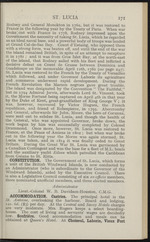 |
“...and
Guadeloupe on the memorable April 12th, 1782 (see page 247).
St. .Lucia was restored to the French by the Treaty of Versailles
which followed, and under Governor Laborie its agriculture
and ..commerce underwent rapid development. During the
French Revolution the Maroon negroes gave great trouble.
The island was designated by the Convention “ The Faithful,”
but in 1,794 Admiral Jervis, afterwards Lord St. Vincent, took
it, the IVforne Fortuné being captured on April 4th in that year
by the Duke of Kent, great-grandfather of King George V; it
was, however, recovered by Victor Hugues, the French
republican, and friend of Robespierre, in 1795. Abercromby
and General, afterwards Sir John, Moore, the hero of Corunna,
were sent out to subdue St. Lucia, and though the health of
the General, who was appointed Governor, broke down, the
work begun by him was successfully completed by Colonel
Drummond. Once more, however, St. Lucia was restored to
France, at the Peace of Amiens in 1802 ; but when...”
|
|
| 13 |
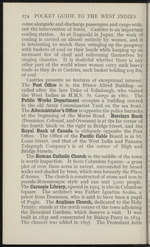 |
“...almost entirely by women, and it
is interesting to watch them swinging up the gangway
with baskets of coal on their heads while keeping up an
incessant fire of chaff and enlivening themselves by
singing chanties. It is doubtful whether there is any
other part of the world where women carry such heavy
loads as they do at Castries, each basket holding iog lbs.
of coal.
Castries presents no features of exceptional interest.
The Post Office is in the Prince Alfred Building—so
called after the late Duke of Edinburgh, who visited
the West Indies in H.M.S. Si. George in 1861. The
Public Works Department occupies a building erected
in the old Army Commissariat Yard on the sea front.
The Administrator’s Office is opposite the police barracks
at the beginning of the Mome Road. Barclays Bank
(Dominion, Colonial, and Overseas) is at the far comer of
the fourth block on the right in Bridge Street, and the
Royal Bank of Canada is obliquely opposite the Post
Office. The Office of the Pacific Cable Board...”
|
|
| 14 |
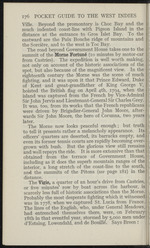 |
“...the entrance to Gros Islet Bay. To the
eastward are the Paix Bouche ridge of mountains and
the Sorcière, and to the west is Toe Bay.
The road beyond Government House takes one to the
summit of the Mome Fortuné (10 minutes by motor-car
from Castries). The expedition is well worth making,
not only on account of the historic associations of the
spot, but also because of the magnificent view. In the
eighteenth century the Mome was the scene of much
fighting, and it was upon it that Prince Edward, Duke
of Kent and great-grandfather of King George V,
hoisted the British flag on April 4th, 1794, when the
island was captured from the French by Vice-Admiral
Sir John Jervis and Lieutenant-General Sir Charles Grey.
It was, too, from its works that the French republicans
were driven by Brigadier-General John Moore, after-
wards Sir John Moore, the hero of Corunna, two years
later. i
The Mome now looks peaceful enough; but truth
to tell it presents rather a melancholy appearance. Its
officers’ quarters...”
|
|
| 15 |
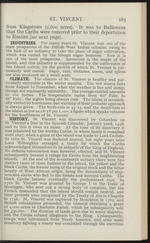 |
“...St. Vincent
subsequently became a refuge for Caribs from the neighbouring
islands. At the end of the seventeenth century there were two
distinct rices of these Indians in the island, the yellow and the
black Caribs, the former being of the original stock and the latter
largely of West African origin, being the descendants of ship-
wrecked slaves who fled to the forests and married Caribs. The
black Caribs became eventually the predominant race. In
1722 St. Vincent was granted by George I to the Duke of
Montague, who sent out a strong body of colonists, but the
French demanded that the island should remain neutral, and
their protests were recognised by the Treaty of Aix-la-Chapelle
in 1748. St. Vincent was captured by Monckton in 1762, and
British colonisation proceeded, the General obtaining a grant
of 4,000 acres in Charlotte Parish, which he subsequently sold
for £30,000. The division of lands gave rise to many disputes,
and the Caribs refused allegiance to the King. Consequently,
troops...”
|
|
| 16 |
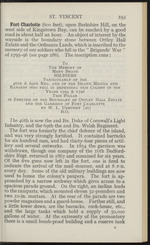 |
“...Ottley Hall
Estate and the Ordnance Lands, which is inscribed to the
memory of our soldiers who fell in the “ Brigands’ War ”
of 1795-96 (see page 186). The inscription runs:
T9
The Memory of
Many Brave
SOLDIERS
Particularly of the
46th & 69TH Reg. and of the Island Militia and
Rangers who fell in defending this Colony in the
Years 1795 & 1796
This Pillar
is Erected on the Boundary of Ottley Hall Estate
and the Garrison of Fort Charlotte
by W. L. Uebuury [sic]
B.O.
The 46th is now the 2nd Bn. Duke of Cornwall’s Light
Infantry, and the 69th the 2nd Bn. Welsh Regiment.
The fort was formerly the chief defence of the island,
and was very strongly fortified. It contained barracks
for six hundred men, and had thirty-four pieces of artil-
lery and several outworks. In 1854 the garrison was
withdrawn, though one company of the 16th Bedford-
shire Regt. returned in 1867 and remained for six years.
Of the five guns now left in the fort, one is fired to
indicate the arrival of the mail steamer, and...”
|
|
| 17 |
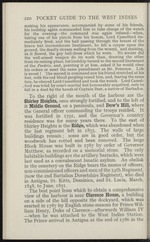 |
“...lunatic asylum. An obelisk
in the cemetery on the Ridge bears the names of officers,
non-commissioned officers and men of the 54th Regiment,
(now the 2nd Battalion Dorsetshire Regiment), who died
in Antigua, St. Kitts, Dominica, and St. Lucia, March,
1848, to June, 1851.
The best point from which to obtain a comprehensive
view of the harbour is near Clarence House, a building
on a side of the hill opposite the dockyard, which was
erected in 1787 by English stone-masons for Prince Wil-
liam Henry, Duke of Clarence—afterwards William IV
—when he was attached to the West Indies Station.
The Prince arrived in Antigua at the end of 1786 in the...”
|
|
| 18 |
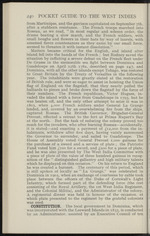 |
“...£200 for a piece of plate,
and he was also presented by The West India Committee with
a piece of plate of the value of three hundred guineas in recog-
nition of the " distinguished gallantry and high military talents
which he displayed on this occasion.” On his return to England
he was created a baronet. The centenary of this period, which
is still spoken of locally as “ La Grange," was celebrated in
Dominica in 1905, when an exchange of courtesies by cable took
place between the officers of the Duke of Cornwall’s Light
Infantry, which formed part of the defending force (the rest
consisting of the Royal Artillery, the 1st West India Regiment,
and the Colonial Militia), and the Administrator of the colony.
A regimental dinner was held in honour of the occasion, at
which plate presented to the regiment by the grateful colonists
was used.
CONSTITUTION. The local government in Dominica, which
was incorporated with the Leeward Islands in 1833, is conducted
by an Administrator, assisted by an Executive...”
|
|
| 19 |
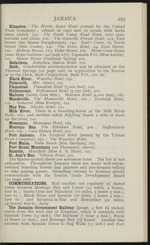 |
“...JAMAICA 259
Kingston. The Myrtle Bank Hotel (owned by the United
Fruit Company) ; rebuilt in igjo and 50 rooms with baths
since added, 25s. The South Camp Road Hotel, very com-
fortable and clean, 21 s.' The Grenville Private Hotel, 112, East
Street (the Misses Farquharson), 14s. Earl’s Court, 18, North
Street (Mrs. Cooke), 14s. The Doric Hotel, 94, East Street,
165. Melrose House, 117, Duke Street, 16s. Mona Great House
(near Hope Gardens—see page 276), Liguanea P.O. (Miss Austin),
125. Manor House (Constant Spring) 20s.
Balaclava. Balaclava Station Hotel, 12s.
Bath. Comfortable accommodation can be obtained at the
Thermal Springs (see page 296) on application to the Matron
or to the Clerk, Bath Corporation, Bath P.O., 10s. 6d.
Black River. Waterloo Hotel, 14s.
Falmouth. Mrs. Steer’s, 12s.
Flamstead. Flamstead Hotel (3,000 feet), 10s.
Hollymount. Hollymount Hotel (2,750 feet), 20s.
Malvern (Santa Cruz Mts.). Malvern Hotel (2,000 feet), 16s.
Mandeville. The Mandeville Hotel, 16s.; Newleigh...”
|
|
| 20 |
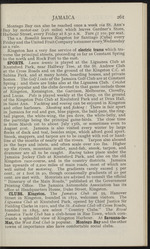 |
“...Knutsford Park, and also on the old
Kingston race-course, and in the country districts. Jamaica
has upwards of 2,200 miles of main roads, most of which are
r well suited for motoring. The gradients rarely exceed 5 per
cent., or x foot in 20, though occasionally gradients of 20 per
cent, are met with. Motorists are advised to consult the official
“ Itinerary of the Main Roads,” published at the Government
Printing Office. The Jamaica Automobile Association has its
office at Headquarters House, Duke Street, Kingston.
CLUBS. Kingston. The Jamaica Club at 59, Hanover
Street in Kingston, founded in 1872, welcomes visitors. The
Liguanea Club at Knutsford Park, opened by Chief Justice Sir
i Fielding Clarke in 1910, and the St. Andrew Club off Cross Roads,
founded in 1895, are select “ Country Clubs.” The Royal
Jamaica Yacht Club has a club-house in Rae Town, which com-
mands a splendid view of Kingston Harbour. At Savanna-la-
Mar, the West End Club is popular. Montego Bay and the other
- towns...”
|
|
